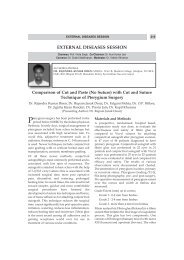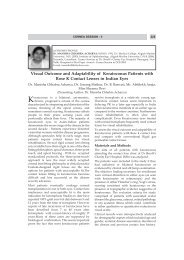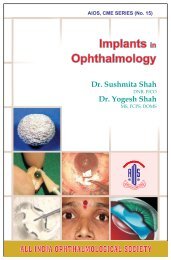Intravitreal Combined Bevacizumab with Dexamethasone for ...
Intravitreal Combined Bevacizumab with Dexamethasone for ...
Intravitreal Combined Bevacizumab with Dexamethasone for ...
Create successful ePaper yourself
Turn your PDF publications into a flip-book with our unique Google optimized e-Paper software.
RETINA/ VITREOUS SESSION-I<br />
<strong>Intravitreal</strong> <strong>Combined</strong> <strong>Bevacizumab</strong> <strong>with</strong> <strong>Dexamethasone</strong> <strong>for</strong><br />
Treatment of Diffuse Macular Oedema in BRVO<br />
Dr. Shroff Rahul Ashok, Dr. Anand Shroff, Dr. Ashok Shroff<br />
(Presenting Author: Dr. Shroff Rahul Ashok)<br />
Branch retinal vein occlusion is a retinal<br />
vascular disorder <strong>with</strong> concomittent macular<br />
oedema is frequently the cause of vision loss. The<br />
current gold standard is macular grid<br />
photocoagulation, but patients but patients<br />
derive only limited benefit. Treatment <strong>for</strong><br />
macular oedema are mainly aimed at reducing<br />
the macular thickness. Corticosteroids inhibit the<br />
expression of VEGF and along <strong>with</strong> their antiinflammatory<br />
properties may be effective<br />
therapy <strong>for</strong> macular oedema. The score study<br />
comparing the safety and efficacy to<br />
triamcinolone acetonide showed no difference in<br />
vision between treated group and standard care<br />
group. However the incidence of cataract and<br />
glaucoma due to the use of triamcinolone was<br />
much higher in the treated group. Studies show<br />
that intravitreal <strong>Bevacizumab</strong> targets the<br />
vascular endothelial growth factor(VEGF) and<br />
can help to reduce the macular oedema.. The<br />
purpose of the study is to show that given in<br />
conjunction <strong>with</strong> dexamethasone it can prolong<br />
the action of treatment.<br />
Materials and Methods<br />
The inclusion criteria was recent branch retinal<br />
573<br />
vein occlusion <strong>with</strong> macular oedema involving<br />
the fovea <strong>with</strong> diffuse macular oedema seen on<br />
fluorescein angiography and a central macular<br />
thickness of >250 micron seen on OCT.<br />
Exclusion criteria was retinal or macular<br />
pathology other than BRVO, advanced cataract,<br />
glaucoma and vitreous haemorrhage.<br />
The primary outcome measure was gain in visual<br />
acuity from baseline and a reduction in central<br />
macular thickness on OCT from baseline.<br />
All patients underwent a BCVA test, IOP check,<br />
slit-lamp examination, fundus examination,<br />
fluorescein angiography and OCT at baseline.<br />
Patients were injected 1.25mg <strong>Bevacizumab</strong> and<br />
700Ugm <strong>Dexamethasone</strong> intravitreally.<br />
Patients were called <strong>for</strong> a followup every 4 mths.<br />
Criteria <strong>for</strong> reinjection were if there was increase<br />
macular edema compared to earlier visit. BCVA,<br />
IOP check, fundus examination and OCT were<br />
done on each visit. Statistical analyses was done<br />
using paired t test to evaluate significance and<br />
95% confidence interval <strong>for</strong> mean change.<br />
Results<br />
The mean followup was 12 mths. The mean best
574 AIOC 2010 PROCEEDINGS<br />
corrected visual acuity was 6/24 (95% confidence<br />
interval – 6/18 to 6/36) at baseline and 6/24 (95%<br />
confidence interval – 6/12 to 6/60) at final<br />
followup. Paired t test showed p value = 0.58 .<br />
The mean central macular thickness(CMT) was<br />
370 microns (95% confidence interval –<br />
344microns to 396microns) at baseline and 221<br />
microns (95% confidence interval – 206microns<br />
to 236microns) at final followup. . Paired t test<br />
showed p value = 0.006 <strong>for</strong> central macular<br />
thickness.<br />
<strong>Intravitreal</strong> <strong>Combined</strong> <strong>Bevacizumab</strong> <strong>with</strong><br />
<strong>Dexamethasone</strong> injection showed no statistically<br />
significant change in vision after treatment.<br />
However there was significant improvement in<br />
the macular oedema seen on OCT. Also there<br />
was no correlation between macular thickness<br />
and visual acuity.










